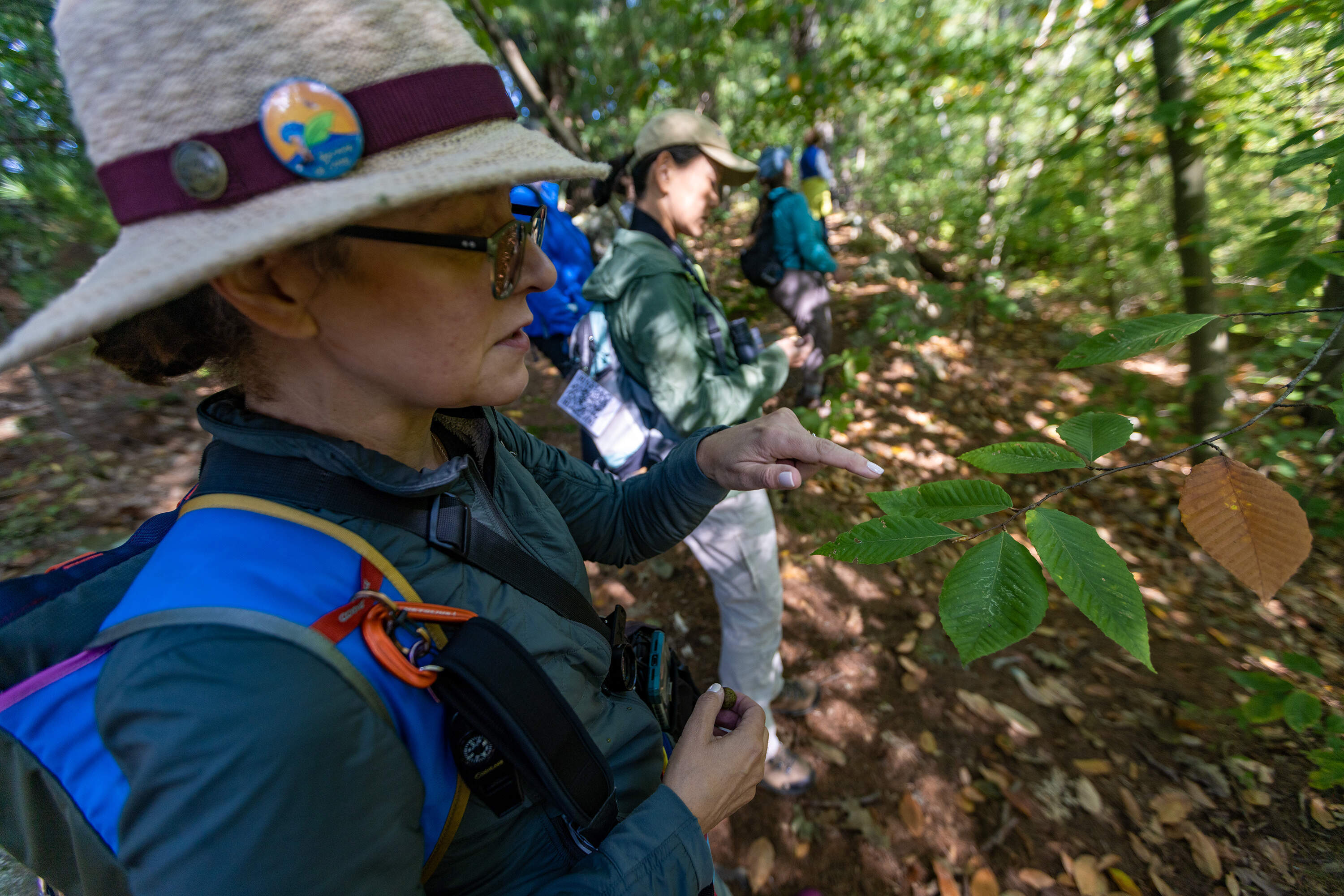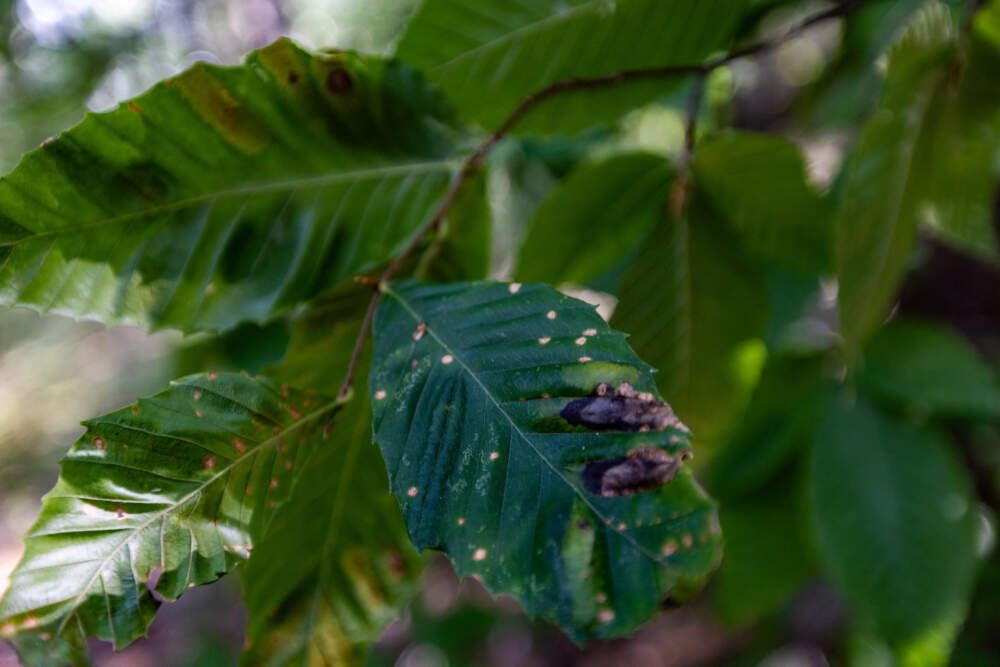

This article is part of The State of Science, a series featuring science stories from public radio stations across the United States. This story, by Paula Moura, was originally published by WBUR.
A new tree disease has spread in forests in Massachusetts, joining invasive pests and climate change as top priorities for foresters to address.
The state has found beech leaf disease in more than 90 communities since it was first discovered in the state in 2020.
“Lately this has been one of our biggest concerns and my team devotes a lot of time to it. We do expect to see a lot of long-term impact and trees lost from it,” said Nicole Keleher, forest health program director at the state Department of Conservation and Recreation.
Beech leaf disease is caused by an unusual parasite: a nematode, which is a microscopic roundworm, that infects the leaves and buds. Researchers believe that it may be spread by birds, insects and wind. This makes it more difficult to treat than visible insects like the emerald ash borer that can be somewhat contained by asking people not to transport wood between forests, according to Keleher.
Infected leaves can develop dark patches or stripes, and often will curl up. The infection causes the tree’s leaves to fall off and can eventually starve the tree, which can die within a few years.

In areas “where we first identified the disease, we’re seeing a significant amount of decline and occasional occurrences of tree death,” said Keleher. The most affected areas are Plymouth and Bristol counties, where the disease was first identified, and Cape Cod.
Native to the eastern U.S., the American beech has a smooth gray trunk and a wide canopy. The U.S. Forest Service estimates it represents 10% of forests in Massachusetts. The tree is also planted along streets, parks and cemeteries. It provides habitat and many animals feed on beechnuts.
Beech leaf disease was first found in the U.S. in Ohio in 2012 and has spread to over a dozen states. While the disease is moving fast, research is still in early stages. For instance, it took five years just to confirm that the infection was caused by a worm. Experts say finding treatments will take more time.
“There is a lot of work going into investigating different chemicals and methods and methodologies. But it’s a slow process,” said Keleher.
The most promising treatment so far comes from a chemical typically used as a fertilizer, said Robert Marra, a forest pathologist with the state of Connecticut who is part of a national beech leaf disease research group.
“In very simple terms it is believed that [the chemical] stimulates the plant’s defenses,” he said.

It’s also nontoxic and relatively cheap. Marra said researchers in Ohio have strong evidence it helps trees to live and thrive with the infection, but the study’s results haven’t been published yet.
And some trees appear to be able to tolerate the disease without any help.
“We see trees that are surrounded by trees that are succumbing rather dramatically to the disease. And these few trees have few symptoms,” he said.
Researchers at the Holden Arboretum in Ohio are studying these seemingly resistant trees in hopes that they could breed them and use them in reforestation. But it’s too early to say if these trees are actually resistant.
Massachusetts state forest officials say there isn’t enough evidence to adopt any treatments yet. For now, they’re monitoring the spread of the disease.
And this is where volunteers come in. In some cases, citizen observations have alerted state foresters to new occurrences of the disease.

The conservation group Earthwise Aware does weekly plant and wildlife surveys of the Middlesex Fells in Winchester, and has documented cases of beech leaf disease there.
“We can really alert very early when there is an issue,” said Claire O’Neill, director of the nonprofit’s biodiversity and climate participatory science program. She said that because they look at the ecosystem as a whole, they can spot what is unusual.
O’Neill and her group uploads the information about trees infected to the website i-Naturalist and other citizen science reporting tools. Those can serve as a starting point for the state’s Forest Health Program to monitor the spread of the disease.
American beech also face other threats, which may make them more vulnerable to the leaf disease. For almost a century, the trees have suffered from beech bark disease, a combination of insect and fungus attacks on the tree trunk. The infection wiped out most big beech trees in Massachusetts’ forests.

The trees also face challenges from extreme weather spurred by climate change. In general, they have been more resilient to heat and drought compared to other trees in the Northeast, said Pamela Templer, a biology professor at Boston University.
“A really important thing to understand is how climate change might be making these trees vulnerable to this pest. But I think it’s too early to say,” she said.
While researchers are trying to find treatments, the state is monitoring the spread of the disease. Individuals can help by filing a survey at the Department of Conservation and Recreation’s website.
For now, the main recommendation for people who have beech trees in their yards is to give them nutrients and water so they’re strong enough to fight the disease.
Segment Guests
Paula Maura is a climate and environment reporter at WBUR in Boston, Massachusetts.
Segment Transcript
FLORA LICHTMAN: This is Science Friday. I’m Flora Lichtman. It’s time to check in on the state of science.
[INTRO MUSIC]
SPEAKER 1: This is KERA News.
SPEAKER 2: For WWNO–
SPEAKER 3: Saint Louis Public Radio–
SPEAKER 4: Iowa Public Radio News.
FLORA LICHTMAN: Local science stories of national significance. You’ve probably heard about the Emerald Ash Borer or maybe Dutch Elm disease. Well, let me add another to the list. Beech leaf disease is also felling trees. It was first identified in 2012 in Ohio, and now the disease is popping up in beech trees across the country, and scientists are still trying to figure out how to treat it. Joining me now to talk more about her reporting on beech leaf disease and how it’s affected Massachusetts beech trees is my guest, Paula Moura, Climate and Environment Reporter at WBUR, based in Boston, Massachusetts. Paula, welcome to Science Friday.
PAULA MOURA: Thanks for having me.
FLORA LICHTMAN: So I just introduced you with your official title, but I heard you have another job these days.
PAULA MOURA: Yeah. Today, my job is beech.
FLORA LICHTMAN: [LAUGH] For beech trees.
PAULA MOURA: Yes, for beech trees.
FLORA LICHTMAN: Just like naturalist Ken doll.
PAULA MOURA: Yes. [LAUGHS]
FLORA LICHTMAN: So what causes beech leaf disease?
PAULA MOURA: Yeah, so it’s caused by a microscopic nematode, which is a worm. When you think of a worm, you think they live in the soil, right? But this one lives in the leaf and leaf buds. Scientists believe it may be spread by birds, insects, and wind.
FLORA LICHTMAN: What does it look like when a tree is infected with the disease?
PAULA MOURA: The leaves can get a dark stripe or become curled. The leaves also fall off. So the canopy, you can see it doesn’t provide shadow, as it used to do. I joined the group of volunteers that spotted the tree with beech leaf disease in the bark here in Massachusetts, near Boston. And I spoke with Claire O’Neill, who is with the conservation nonprofit Earthwise Aware.
[AUDIO PLAYBACK]
– When you stand underneath the tree with the reflection of the light going through the leaf, you can see these kind of little, rectangular patches of very dark color. This is what is a sign of the leaf disease.
[END PLAYBACK]
FLORA LICHTMAN: How long does it take for this to do really serious damage to the tree or to kill the tree?
PAULA MOURA: The trees usually die in a few years.
FLORA LICHTMAN: Wow. How fast does it spreading?
PAULA MOURA: Yeah, it was first identified in Ohio in 2012, and now it has spread over a dozen states. It was identified in Massachusetts for the first time in 2020. And it was identified in three communities, and now it has spread over 90 communities.
FLORA LICHTMAN: Wow.
PAULA MOURA: Yeah, it’s very fast.
FLORA LICHTMAN: Is there a way to treat trees infected with the disease?
PAULA MOURA: So researchers say finding treatments will take more time. They’ve just begun studying this disease. For example, it took five years just to confirm that the infection was caused by a nematode. But the most promising treatment so far comes from a chemical typically used as a fertilizer. When they’ve treated trees with the fertilizer, they found that those trees seem to be healthier. More of the buds survive and thrive with the nematode on it, and the leaves too.
And some trees seem to be resistant on their own. Researchers in Ohio are studying these specimens in hopes that they could breed them and use them in reforestation. But the study is still ongoing, so they don’t know if the trees have some genetic resistance or if there are other factors that are helping the trees.
FLORA LICHTMAN: How does climate change factor into all of this?
PAULA MOURA: There might be some good news here. In general, beech trees have been more resilient to extreme weather exacerbated by climate change, like heat and drought, in comparison to other trees here in the Northeast. I spoke to Pamela Templer, a professor at Boston University. She says it’s too early to know the impact of climate change in relation to the disease.
[AUDIO PLAYBACK]
– A really important thing to understand is how climate change might be making these trees vulnerable to this pest, but I think it’s too early to say.
[END PLAYBACK]
PAULA MOURA: It took five years just to confirm the infection was caused by a nematode, so finding a treatment will take more time.
FLORA LICHTMAN: The researchers you talk to, do you get the sense that they’re concerned about this?
PAULA MOURA: Here, in Massachusetts, beech leaf disease raised to one of the top concerns for the State Forest Health Program. And I spoke to the director, Nicole Keleher, and she said she expects to see a lot of tree death. And I could tell like everyone is concerned and really want to find the treatment that would help.
FLORA LICHTMAN: Thank you for sharing your reporting with us, Paula.
PAULA MOURA: Thank you for having me.
FLORA LICHTMAN: Paula Mara, Climate and Environment Reporter at WBUR, based in Boston, Massachusetts. If you want to learn more about how to tell if a tree is infected by beech leaf disease and how scientists are trying to treat it, go to sciencefriday.com/leaf.
Copyright © 2023 Science Friday Initiative. All rights reserved. Science Friday transcripts are produced on a tight deadline by 3Play Media. Fidelity to the original aired/published audio or video file might vary, and text might be updated or amended in the future. For the authoritative record of Science Friday’s programming, please visit the original aired/published recording. For terms of use and more information, visit our policies pages at http://www.sciencefriday.com/about/policies/
Meet the Producers and Host
About Shoshannah Buxbaum
Shoshannah Buxbaum is a producer for Science Friday. She’s particularly drawn to stories about health, psychology, and the environment. She’s a proud New Jersey native and will happily share her opinions on why the state is deserving of a little more love.
About Flora Lichtman
Flora Lichtman is a host of Science Friday. In a previous life, she lived on a research ship where apertivi were served on the top deck, hoisted there via pulley by the ship’s chef.